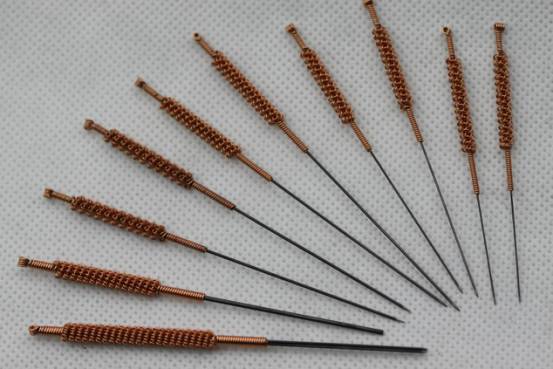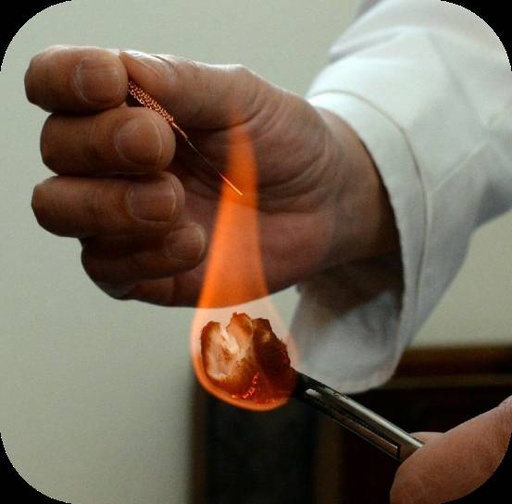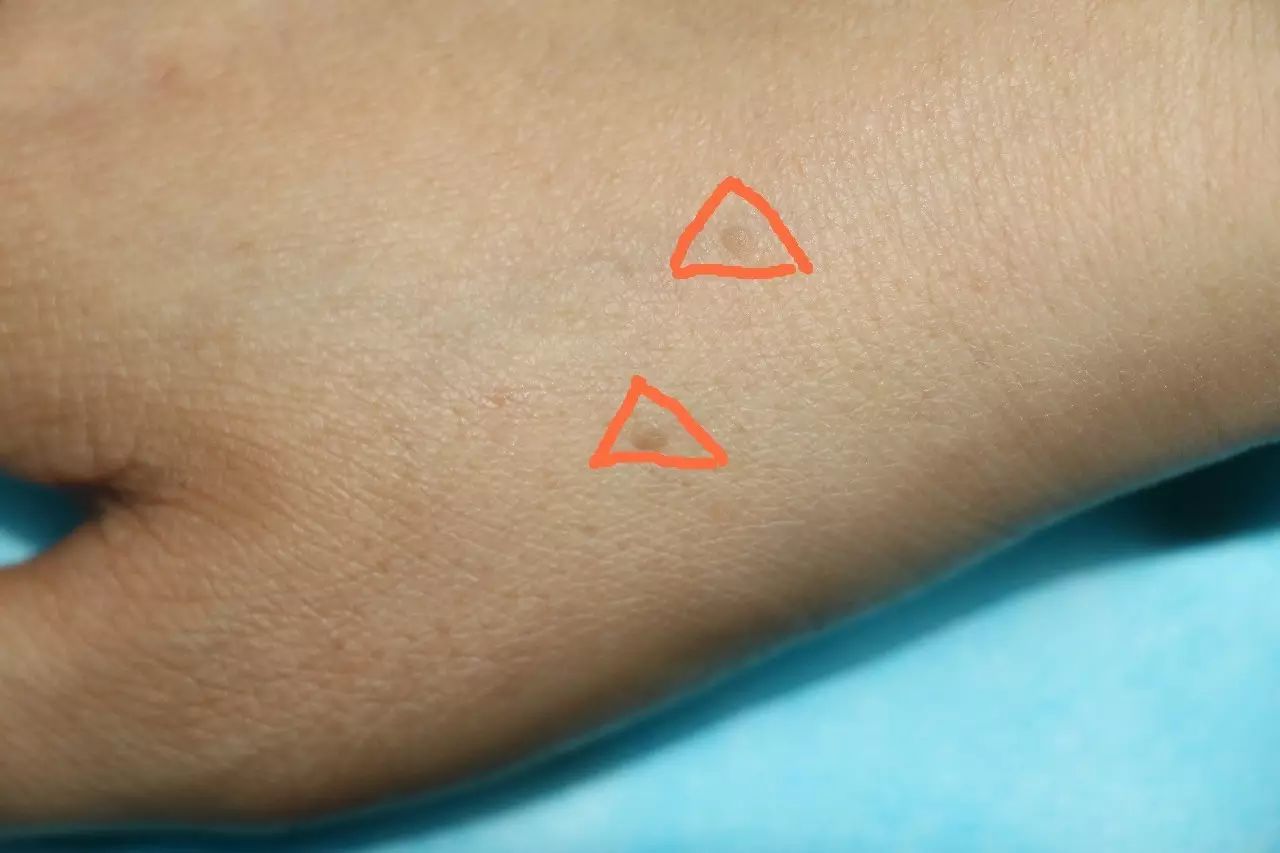Fire Needle Therapy for Flat Warts
Warts are a common chronic viral skin disease, clinically manifested as wart-like growths with contact transmissibility. Today, we will introduce one type of wart: flat warts. If you have the following two questions:
1. Why do I have several small bumps on the back of my hand that are the same color as my skin and occasionally itch?
2. Why do more “small bumps” appear after I scratch the ones on my face? Perhaps after reading this article, you will gain some insights. First, let us understand flat warts, which are referred to as bian shou (扁瘊) in Traditional Chinese Medicine (TCM).
Clinical Characteristics of Flat Warts:
1. Skin lesions appear suddenly, presenting as flat, firm papules ranging from the size of a grain of rice to a green bean, with a smooth surface slightly elevated above the skin, and clear borders.
2. The shapes are mostly round, oval, or slightly irregular; the color is either normal skin color or gray-brown. 3. The number is variable, scattered in distribution, and after scratching, several papules may appear along the scratch line in a bead-like arrangement.
3. This condition commonly occurs on the face, back of the hands, and forearms, often seen in adolescents, and may spontaneously resolve over time. If you think the “small bumps” you have match the above points, please take a couple more minutes to read our following sharing.

Treatment Methods
Now, we will introduce an effective treatment method for flat warts—fire needle therapy. TCM believes that when the body’s vital energy is weak and is invaded by the “wind-heat evil,” it forms heat toxins within the body, and flat warts are a manifestation of these heat toxins on the skin surface. Fire needle therapy for flat warts utilizes the TCM principle of using heat to draw out heat; the fire needle can expel the heat toxins from the wart through the skin’s collaterals. Its higher temperature will also solidify the liquid inside the wart, preventing infection. Furthermore, the heat can accelerate blood circulation, invigorate Yang energy, and help eliminate the latent heat toxins in the skin. Through fire needle therapy, not only can the disease be treated effectively, but generally, it will not leave you troubled by scarring or pigmentation.
Contraindications
1. Pregnant women and the elderly or weak individuals should not use this treatment.
2. Fire needles should not be used in areas with large blood vessels or nerve trunks.
3. Patients with hypertension, heart disease, hemophilia, or bleeding tendencies should avoid this treatment.

Selected Previous Content:
Recruitment—Clinical Research Volunteers for Atopic Dermatitis (Active Phase)
About the Clinical Application of Fire Needle Therapy
Can Thread Embedding Really Help with Weight Loss?!
Acupuncture Therapy for Skin Diseases
Stay tuned for more exciting content in the next issue. (Editor: Zhao Zhijin)
Acupuncture Team of the Dermatology Department, Shaanxi Provincial Hospital of Traditional Chinese Medicine
Acupuncture treatment is a significant component of the TCM diagnostic and therapeutic system, and its role in treating skin diseases has received widespread acclaim from both medical professionals and patients. We actively promote acupuncture and related treatment methods based on the characteristics of our specialty, forming a service model of acupuncture treatment that is “clinical-based, multidisciplinary research, and returning to clinical practice.” We have gradually established a well-structured acupuncture treatment team with a reasonable age distribution, balanced educational background, and distinct TCM characteristics.
The team consists of personnel with years of acupuncture experience or qualifications, including 1 chief physician, 2 associate chief physicians, 1 attending physician, and 5 resident physicians; 2 PhDs, 3 Masters. Our team is grounded in traditional TCM theories and acupuncture treatment, focusing on the clinical effectiveness and safety of acupuncture and its mechanisms, using disease differentiation and point selection as entry points for clinical research. The goal of the research is to provide new solutions for clinical practice to improve therapeutic efficacy.
Currently, our team focuses on three major disease categories: psoriasis, herpes zoster (including postherpetic neuralgia), and scleroderma, as well as allergic diseases such as eczema, urticaria, and nodular prurigo. Based on the different characteristics of patients’ diseases, we have formed a six-system acupuncture treatment model for skin diseases:
1. Facial diseases (such as acne, melasma, hormone-dependent dermatitis, etc.) primarily use body acupuncture, facial acupuncture, facial guasha, back guasha, fire needle therapy, ear acupuncture, and thread embedding treatment. Based on the symptoms of skin lesions combined with tongue and pulse diagnosis, facial acupuncture is prioritized, and appropriate body acupuncture is selected based on differentiation.
2. Erythematous scaly diseases (psoriasis in stationary and regression phases) involve surrounding needling, plum blossom needle puncture, cupping therapy, and wandering cupping.
3. Allergic diseases (such as urticaria, eczema) have a rich variety of treatment methods: body acupuncture, cupping therapy, autologous blood therapy, point application, ear seed pressure, and point injection, which need to be selected based on skin symptoms and tongue-pulse differentiation.
4. Connective tissue diseases (such as scleroderma) show significant effects with surrounding needling combined with moxibustion for treating localized scleroderma.
5. Painful diseases (such as postherpetic neuralgia) focus on pain relief, primarily using surrounding needling, shallow needling, plum blossom needle puncture, bloodletting, and point injection at the pain site.
6. Beauty (weight loss) primarily uses acupuncture, cupping, ear seed pressure, and thread embedding. Especially, patients undergoing thread embedding show significant compliance and treatment effects.
In recent years, under the guidance of the above research model, our team has conducted clinical-driven research and research-guided clinical studies on common and difficult skin diseases such as scleroderma and vitiligo, achieving a series of advancements. Among them, Chief Physician Yan Xiaoning’s research on the “cAMP/PKA signaling pathway in scleroderma and the clinical research and application promotion of surrounding needling, moxibustion, and herbal hot compresses” won the second prize for scientific and technological achievements in Shaanxi Province, providing new ideas for the clinical diagnosis and treatment of scleroderma.
A meaningful study must be based on clinical efficacy and social needs. If we can innovate acupuncture treatment based on the traditional acupuncture theoretical system while drawing on modern scientific knowledge and technological means, it is worth the efforts of all TCM practitioners. Currently, all staff in the Dermatology Department of Shaanxi Provincial Hospital of Traditional Chinese Medicine, under the leadership of Department Head Yan Xiaoning, are working hard, continuously innovating, and developing various treatment methods, gradually improving therapeutic efficacy. All staff are united, striving to keep pace with the times, and sincerely serving every patient.
Shaanxi Provincial Hospital of Traditional Chinese Medicine Dermatology Department Introduction
The Shaanxi Provincial Hospital of Traditional Chinese Medicine Dermatology Department was formerly the Dermatology Department of Shaanxi Provincial Hospital of Traditional Chinese Medicine, founded by Professor Zhu Xinggong from a family of TCM practitioners in the 1960s. Since its establishment, it has inherited traditional medical therapies, introduced advanced diagnostic and therapeutic techniques from modern medicine, and highlighted the advantages of TCM. It has now developed into a clinical research institution for skin diseases with significant TCM characteristics in the Northwest region. It is currently a national clinical key specialty, a key specialty of the National Administration of Traditional Chinese Medicine during the 12th Five-Year Plan, a key discipline of the Shaanxi Provincial Administration of Traditional Chinese Medicine, the Shaanxi Clinical Research Center for TCM Dermatology, a master’s training point for Shaanxi University of Traditional Chinese Medicine, and the chair unit of the Dermatology Professional Committee of the Shaanxi Association of Integrative Medicine and the Shaanxi TCM Science and Technology Development Committee. In 2016, the Shaanxi Provincial Hospital of Traditional Chinese Medicine Dermatology Department and the Shaanxi Institute of Traditional Chinese Medicine Dermatology Research were established under the original department framework.
Currently, there are 55 medical staff, including 32 doctors, among whom there are 5 chief physicians, 5 associate chief physicians, 9 attending physicians, 1 national master of TCM (special expert), 1 visiting scholar from the Central Organization Department’s “West Light” program, 1 famous TCM physician in Shaanxi Province, 1 master’s supervisor, 1 postdoctoral fellow, and 5 PhDs. The department has established the work studio of Master Xuan Guowei, the work studio of famous TCM physician Han Shirong, a photon laser studio, a dermatological surgical room, a TCM characteristic treatment room, an allergen and fungal testing room, etc. Currently, there are 50 open beds, 5 outpatient rooms, with an annual outpatient volume of over 120,000 visits, over 1,100 inpatient admissions, and over 600 surgeries performed annually.
The main disease specialties of the Dermatology Department are psoriasis, eczema, herpes zoster, and scleroderma, while also forming characteristics in treating urticaria, vitiligo, acne, melasma, hair loss, and scars, continuously breaking through in the diagnosis and treatment of difficult diseases. Currently, over 20 types of pure TCM hospital preparations have been approved, and more than 20 types of TCM characteristic therapies have been developed. In recent years, we are actively exploring the application of acupuncture treatment in various skin diseases.
Through years of development, the Dermatology Department has distinct TCM characteristics, and the overall level of clinical, research, and teaching is relatively high, with a certain influence in the Northwest region and even nationwide.
In recent years, we have undertaken over 30 national and provincial-level projects, among which Chief Physician Yan Xiaoning’s system of combining hot compresses, surrounding needling, and moxibustion for treating scleroderma won the second prize for scientific and technological achievements in Shaanxi Province.
All images in the text are sourced from the internet.



